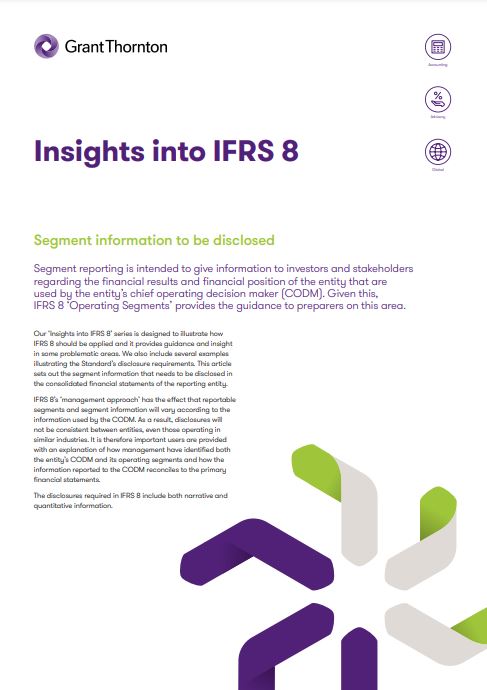-
Corporate Tax
We are your problem solvers for corporate tax issues
-
Restructuring, Mergers & Acquisition
Expertise and creativity for the perfect structure
-
International Tax
We are here, whenever our clients require our assistance
-
Transfer pricing
We are your experts for an optimal transfer pricing structure
-
Indirect Tax & Customs
We take care of your indirect taxes so you can take care of your business
-
Private Wealth
We are your competent partner in the field of Private Wealth Tax Services
-
Real Estate Tax
We are a valuable partner at every stage of your property's life
-
Global Mobility Services
Local roots and global networking as a secret for successful assignment management
-
Advisor for Advisor
As advisors for advisors, we support in complex situations
-
Accounting & Tax Compliance Services
Grant Thornton Austria - Your Partner for Experts for Accounting & Tax Compliance Services. In an evolving regulatory landscape, efficient accounting, tax compliance, and financial statement preparation processes are crucial for maintaining an accurate and up-to-date view of your company’s financial position while ensuring compliance with all legal requirements. We provide tailored solutions that not only save your time and resources but also ensure compliance with complex regulations. Our experts are here to support you, allowing you to focus on your core business.
-
Payroll & People Advisory Services
Ensuring Compliance, Efficiency, and Strategic HR Solutions In an evolving legal landscape, it is crucial for companies of all sizes to have efficient and legally compliant payroll accounting systems. The ever-changing regulations and increasing complexity make this an ongoing challenge. At Grant Thornton Austria, we provide comprehensive, precise payroll processing as part of our Payroll & People Advisory Services. Additionally, we offer customized advisory services to help clients optimise their HR strategy, improve operational efficiency, and minimize potential risks.
-
Tax Controversy Services
Your Partner when it matters most! In increasingly complex environment and considering frequent changes in tax regulations, businesses are facing intensified scrutiny from tax authorities. This has resulted in a significant rise of complex tax audits, investigations and potential disputes. Our Tax Controversy Services are tailored to help you navigate these challenges proactively and effectively. Our experts will guide you through all stages of tax proceedings, ensuring robust defence of your position and advising you on preventive measures to minimize the risk of future tax disputes.
-
Tax Technology Services
Your digital partner for an efficient future! In an increasingly digitalised business world, companies must constantly look for optimisations and adjustments to ensure their long-term success. In order to best prepare for the future and to achieve efficiency increases and process optimisations in the digital area, the experts at Grant Thornton Austria are at your side as a reliable partner as part of our Tax Technology Services.
-
Audit of annual and consolidated financial statements
We place particular emphasis on customized solutions and international service and adapt our services to your needs.
-
Assurance related advisory services
Assurance related advisory services are based on the knowledge and expertise that are the staff of life of our auditors.
-
Global audit technology
We apply our global audit methodology through an integrated set of software tools known as the Voyager suite.
-
Accounting related consulting
Accounting in accordance with UGB, US-GAAP or IFRS is in constant motion. The integration of new regulations into their own accounting systems poses special challenges for companies.
-
Valuation
Valuations are a core competence of Grant Thornton Austria. As auditors and tax advisors we combine profound know-how with our practical experience to offer you customized solutions for your valuation assignment. Our industry expertise is based on years of services to our clients, including listed companies as well as owner-managed companies with an international focus. We advise on valuation matters related to arbitration and provide expert opinions.
-
Forensic Services
When it comes to risks in business, our experts are on hand. We support you not only in suspicious cases or in disputes, but also develop suitable strategies in the area of prevention to avoid serious cases as far as possible. Our Cyber Security team helps you to keep your networks and applications secure and is quickly on hand in the event of a security leak.
-
Cyber Security
Cyber incidents, IT system failures, the resulting business interruptions and the loss of critical data are one of the greatest business risks for companies. Recent cases underline the need for strategic protection and awareness of the issue and require a holistic approach and technical expertise that takes into account all legislative, regulatory and technical aspects of cyber security to protect companies against the daily increase in cybercrime incidents.
-
Sustainability Services
Sustainability is no longer a trend, but the only way to create a future worth living. Our experts will support you in successfully developing your sustainability strategy and preparing your sustainability reporting in compliance with regulations.
-
Transaction Support
We can support you throughout the transaction process – helping achieve the best possible outcome at the point of the transaction and in the longer term.
-
Merger & Acquisition
Companies start new activities and separate from old ones, cooperate and merge. Markets and competitive conditions are subject to constant and increasingly rapid change. As a result, existing business models are changing. Some companies have to restructure and reorganize. But new business opportunities also open up.
-
Restructuring & Going Concern Forecast
Restructuring & Going Concern Forecast: Bundled services for your strategic, operational and financial decisions offer the right answers for companies, banks, shareholders and investors.
-
Internal Audit
Internal Audit helps companies and organisations to achieve their goals by analysing and evaluating the effectiveness of risk management, controls and management and monitoring processes. Internal Audit focuses on independent and objective audit (assurance) and consulting services that improve the value creation and business activities of your company.
-
Expert dispute resolution & advisory
Grant Thornton Austria offers comprehensive services in the field of business-oriented expert services with a broad range of competencies from banking to communication. The core activity of experts is the objective recording of findings and the preparation of expert opinions - regardless of all external circumstances. Our experts Gottwald Kranebitter and Georg H. Jeitler, as sworn and court-certified experts, ensure that the highest professional standards and the principle of objectivity are observed.
-
Blockchain and Crypto-Asset
Blockchain as a carrier technology for crypto currencies and smart contracts, among other things, is becoming increasingly important. Grant Thornton Austria offers comprehensive audit and confirmation services for block chain technologies and business models.
-
International Project Coordination
Our International Engagement Management team is your central point of contact for international projects in all our service lines. We take care of operational project management for you and act as a central point of contact and coordination for your projects. We support companies that start international projects from Austria as well as companies from abroad that want to gain a foothold in Austria or use Austria as a hub for their international projects, especially in the DACH (Germany, Austria and Switzerland) and CEE region.
-
International Desks
As a member of the Grant Thornton network, we guarantee direct access to resources from our worldwide circle of partners. This global connection enables us to seamlessly integrate highly qualified specialists and industry experts from different countries around the world into our teams. Through our broad perspective and diverse expertise, we ensure that we can optimally meet the individual requirements of our clients in an increasingly globalised economy.
IFRS 8’s ‘management approach’ has the effect that reportable segments and segment information will vary according to the information used by the CODM. As a result, disclosures will not be consistent between entities, even those operating in similar industries. It is therefore important users are provided with an explanation of how management have identified both the entity’s CODM and its operating segments and how the information reported to the CODM reconciles to the primary financial statements.
The disclosures required in IFRS 8 include both narrative and quantitative information.
Disclosure of the factors used to identify segments
IFRS 8 requires an entity to disclose the following general information:
- factors used to identify the entity’s reportable segments, including the basis of organisation, and
- types of products and services from which each reportable segment derives its revenues.
The factors disclosed under the first bullet point above provide the readers of the financial statements with information as to how management has organised the entity. These disclosures should clearly indicate whether segments are based on products and services, geographical areas, regulatory environments or a combination of factors. It should also indicate whether different operating segments have similar economic characteristics and have therefore been aggregated (see Insights into IFRS 8 - aggregation of operating segments). IFRS 8 requires quantitative information to be disclosed using the amounts presented to the CODM. This will often be different to the amounts reported under IFRS appearing in the primary financial statements. Probably the most important judgement made in the application of IFRS 8 is the identity of the function of the CODM, as it is the information that is regularly used by the CODM that forms the basis for segmental reporting. In light of this, while not a formal disclosure requirement in IFRS 8, we believe it is good practice to disclose the individual or group identified as the CODM.
Quantitative information about profit or loss, assets and liabilities
The amounts disclosed for each segment item reflects what has been reported to the CODM. They should be the same amounts the CODM has used to allocate resources to the segment and assess its performance. These amounts will often be different from the measures used in the primary financial statements. Further disclosures are therefore needed to reconcile the segment measures to the primary statements (see reconciliation to IFRS primary financial statements below).
Although IFRS 8 generally requires disclosure on the basis of information used in the business, there are limited circumstances in which entities may need to obtain additional information to meet the requirements of IFRS 8 and they are set out below.
Measure of segment profit or loss
The IASB anticipate some sort of measure of segment profit or loss will be regularly reported to the CODM and so IFRS 8 requires an entity reports a measure of segment profit or loss in all cases. In practice, the measure used by the CODM is likely to vary significantly between entities. Clear disclosure of the measurement basis used to prepare segment results will therefore be very important (see disclosure of measurement policies below).
Measure of segment assets
Where a measure of segment assets is reported to the CODM, that measure is required to be disclosed. In accordance with IFRS 8, the disclosure is based on what is reported to the CODM. If the internal reporting includes, say, cash, inventory and accounts receivables the sum of those three items is what needs to be disclosed.
IFRS 8 requires disclosure of a measure of segment assets. However, the IASB acknowledge, whilst a measure of segment profit or loss is expected in every entity’s internal reporting, there may be circumstances where a measure of segment assets is not included. As a result, a measure of segment assets should only be disclosed when such information is provided to the CODM. This is consistent with the management approach and with the requirement for disclosure of a measure of segment liabilities only when such a measure is reported to the CODM (see below).
Measure of segment liabilities
IFRS 8 requires an entity reports a measure of liabilities for each reportable segment if, and only if, such an amount is regularly provided to the CODM.
Other specified segment measures
IFRS 8 requires disclosure of items when they are either included in the measure of segment profit or loss reviewed by the CODM or they are otherwise regularly provided. This means the management reports presented to the CODM must be reviewed to identify whether these items are either included as separately disclosed amounts or have been charged/credited in arriving at segment results. If so, they must be disclosed. The specified amounts to be disclosed in these circumstances are:
- revenues from external customers
- revenues from transactions with other operating segments of the same entity
- interest revenue
- interest expense
- depreciation and amortisation
- material items of income and expense disclosed in accordance with IAS 1 ‘Presentation of Financial Statements’
- the entity’s interest in the profit or loss of associates and joint ventures accounted for by the equity method
- income tax expense or income, and
- material non-cash items other than depreciation and amortisation.
An entity reports interest revenue separately from interest expense for each reportable segment unless a majority of the segment’s revenues are from interest and the CODM relies primarily on net interest revenue to assess performance and make decisions. In that situation, an entity may report that segment’s interest revenue net of its interest expense and disclose that it has done so.
Example 1
Disclosures for non-reportable segments
Information about other business activities and operating segments that are not separately reportable (after all preceding stages of aggregation and identification of reporting segments have been performed) is then combined and disclosed in an ‘all other segments’ category. A description of the sources of revenue included in this category is required by IFRS 8.
Disclosure of measurement policies
As noted in the quantitative information paragraphs above, IFRS 8 requires disclosure of segment information based on amounts reported to the CODM. Information used for internal management reporting purposes varies widely from entity to entity. For example, the CODM may use profit figures that exclude certain items such as reorganisation costs, non-recurring or unusual items and fair value changes. CODMs in some entities may rely primarily on cash flow-based results.
In developing IFRS 8, the International Accounting Standards Board (IASB) decided that the cost of reduced comparability of information between entities was outweighed by the benefits of increased relevance of the management approach. They also recognised that, in view of the diversity of disclosure bases that arises under a management approach, some explanation and
reconciliation of the segmental information would be necessary.
In addition to a numerical reconciliation between the segment measures reported and those used in the primary financial statements (see reconciliation to IFRS primary financial statements below), IFRS 8 requires an entity to disclose an explanation that enables users to understand the basis on which segmental information is measured.
The explanation should cover as a minimum:
- The basis of accounting for transactions between reportable segments, including transfer pricing policies (eg market prices, cost, or cost-plus).
- The nature of the description of the measurement basis for each reported measure of segment profit or loss, segment assets and segment liabilities, in particular the nature of any differences between these measurements and those used for the entity’s reported profit or loss before income tax expense or income and discontinued operations, or assets and liabilities in the entity’s statement of financial position (unless apparent from the reconciliations described below).
- The nature of any changes from prior periods in the measurement methods used and the effect of the changes.
- The nature and effect of any asymmetrical allocations to reportable segments, for example an entity might allocate depreciation expense to a segment without allocating the related depreciable assets to the segment.
The numerical reconciliations described below may be sufficient to explain some of the more obvious reconciling items, such as inclusion of non-segment revenue from corporate functions that are not operating segments and exclusion of inter-segment revenue in the entity total. The narrative explanation described above may then focus on a description of other differences such as
differences in accounting policies and policies for allocating centrally incurred costs or central assets and liabilities.
Reconciliation to IFRS primary financial statements
In addition to the narrative explanations described above, IFRS 8 requires disclosures to reconcile the segment items with the equivalent entity amounts.
Segment measures to be reconciled
IFRS 8 requires reconciliations of:
- the total of the reportable segments’ revenues to the entity’s revenue
- the total of the reportable segments’ measures of profit or loss to the entity’s profit or loss before tax expense (tax income) and discontinued operations. However, if an entity allocates to reportable segments items such as tax expense (tax income), the entity may reconcile the total of the segments’ measures of profit or loss to the entity’s profit or loss after those items
- the total of the reportable segments’ assets to the entity’s assets
- the total of the reportable segments’ liabilities to the entity’s liabilities (if segment liabilities are reported), and
- the total of the reportable segments’ amounts for every other material item of information disclosed to the corresponding amount for the entity.
Examples of reconciling items include: conversion of segment information reported on a local GAAP basis for segments; inclusion of activities of corporate functions that are not identified as operating segments; and elimination of intra-segment amounts.
The actual amount of each material adjusting item should be disclosed as well as a description.
Amounts relating to the ‘all other segments’ category are disclosed separately from other reconciling items.


